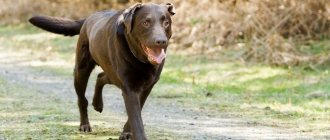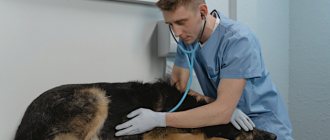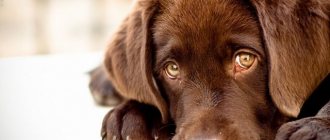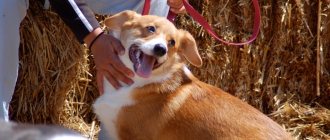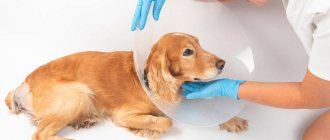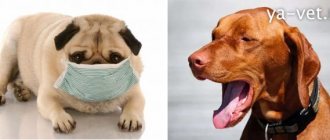Responsible dog owners should take their pet to the veterinarian at least once every six months. After all, dogs, like people, also have problems with their teeth. But if you do not properly monitor the animal’s oral hygiene, then after a while he may simply be left without teeth.
There are times when a dog's teeth rot. What could it be? The cause can be many illnesses and diseases, but the most common are:
- Caries.
- Gingivitis.
- Periodontitis.
Description of the disease
Gingivitis is inflammation of the gums. You can see it by looking at the dog's gums. You will immediately notice that they are noticeably red and swollen.
Gingivitis occurs rarely alone; more often we see inflammation of the entire periodontium (all tissues surrounding the tooth). And, of course, tartar almost always goes hand in hand with gingivitis. Tartar is an unpleasant yellow-brown and sometimes greenish coating on the teeth.
Many people underestimate this pathology - in vain. Gingivitis can have serious consequences.
- Due to the pain (and gum inflammation is undoubtedly a painful process), the dog refuses to eat, which ultimately can lead to exhaustion and metabolic disorders.
- The dog is at risk of losing its teeth if they don’t fall out on their own; in advanced cases, they will have to be removed surgically.
- The inflammatory process, if nothing is done, will continue. First on the palate and pharynx, and then deeper into the digestive tract.
Resorption of dental tissue
Perhaps one of the most unpleasant pathologies in the “dental segment”. This is the name of a disease in which tooth tissue begins to degrade and collapse. It is more often detected in cats, but unfortunately dogs are not spared from this problem either. There are five stages of resorption:
- First. Moderate loss of dental tissue, affecting (only) cementum or enamel. At this stage, you can only notice minor defects on the neck of the tooth (and even then only with a very careful examination). There is no sensitivity, the lesions have not yet reached the deep layers.
- Second. The process of softening of cementum and enamel goes even further, leading to loss of dentin. The damage has not yet reached the pulp of the tooth, there is no pain or sensitivity yet. Only minor defects are visible on the outside.
- Third. The cementum substance, enamel and dentin are already strongly “eaten away” by the destruction process, and at this stage damage to the pulp is often recorded. Pain and increased sensitivity are already noted, but still most of the tooth remains viable.
- Fourth. Extensive loss of bone tissue leads to massive tooth destruction. The remaining tissue after resorption largely loses its solid structure. There are three subcategories: 4a (crown and root damaged equally), 4b (crown more affected) and 4c (root more affected than the crown). Severe pain and sensitivity, but they gradually subside due to the death of the nerves and pulp.
- Fifth. Only a small piece of the tooth remains above the surface of the gum. There is no more pain (as a rule).
Types of gingivitis
Gum inflammation can be acute or chronic.
The acute process develops quickly and is extremely painful. It occurs as a result of mechanical damage to the gums, with further introduction of bacterial flora, or in cases of acute allergic reaction.
The chronic process does not manifest itself so clearly, but also causes severe discomfort to the dog. It occurs against the background of diseases of the internal systems of the body, disorders of the liver and kidneys, the cardiovascular system, and so on.
Gingivitis can also be local and generalized.
Local is when inflammation covers a limited area of the gum.
Generalized means that the inflammation spreads to the entire surface of the gums.
According to its manifestation, gum inflammation can be purulent, catarrhal, hypertrophic and ulcerative.
Catarrhal gingivitis is the most common. The gums are red and swollen and often bleed.
With purulent gingivitis, there is especially bad breath. Upon examination, you can see the exudate itself (pus) and purulent sacs that have formed in the pockets of inflamed gums.
Hypertrophic gingivitis is characterized by the growth of gums along the teeth. This leads to greater trauma, which further aggravates the inflammatory process.
Ulcerative gingivitis is manifested by the formation of areas of ulceration on the gums, in these places the mucous membrane appears to be exposed.
What complications can there be?
Even if the pain has dulled, the symptoms have become less pronounced, you should not postpone your visit to the dentist. This situation may be a signal indicating the death of the root and the further spread of infection to the organs of the head or neck.
The area cannot be heated. This approach will bring short-term relief, but will accelerate the formation of the fistula and stimulate the release of pus.
Possible serious complications: brain inflammation, pneumonia. There is a risk of sepsis, development of osteomyelitis, damage to the nasal sinuses or meninges.
Risk group
All dogs whose owners do not take care of their pet’s oral hygiene are at risk. Namely, they do not perform hygienic teeth cleaning at home and do not bring dogs to the clinic for ultrasonic cleaning to get rid of tartar.
As for breed characteristics, small breeds of dogs are at particular risk, especially if the dog is already over five years old. This is especially true for individuals with malocclusion.
In large breed dogs, on the contrary, similar problems occur more often before the age of two years, especially during or after changing teeth (at about seven months of age).
Commonly used drugs for inflammation
In dentistry, several types of antibiotics are used for toothache and inflammation.
- Penicillin group. Prescribed at any age, with minimal side effects and easy tolerability. The main use is for periodontal inflammation. Effective against anaerobic bacteria.
- Cephalospoirins. They are used when it is necessary to perform dental manipulation with the risk of injury, as well as during periodontal and odontogenic inflammatory processes.
- Tetracyclines. Relieves swelling in the area of bone and soft tissue.
- Imidazole and derivatives. They have a depressing effect on pathogenic microorganisms and quickly penetrate bone tissue. Recommended for extensive inflammatory lesions.
- Macrolides. Used during pregnancy and allergies to drugs of the penicillin group. Eliminates gram-negative and gram-positive bacteria.
- Lincosamides. Do not cause allergies. Used for severe bone tissue infections.
The prescription of osteotropic antibiotics is combined if the tests reveal different types of pathogenic microbes.
Reasons for development
The first and main reason is lack of oral hygiene. No matter what special treats you give your dog for cleaning his teeth, they will not completely get rid of plaque. Sooner or later, it will mineralize and turn into tartar and lead to gingivitis.
Nutritional reason. Simply put, improper feeding. If you feed your dog bones or low-quality dry food, this can lead to many very serious problems.
The most dangerous of them is gum trauma.
The opposite case is feeding exclusively soft food or various cereals. Such a diet leads not only to the accelerated appearance of tartar, but also to weakening of the gums. They become soft, not in good shape, sometimes even loose.
The pathological state of the body is a disease of internal systems. Especially often, gingivitis is caused by disturbances in the functioning of the kidneys and liver. Metabolic disorders, lack of vitamins and microelements also cause inflammation of the gums and weakening of teeth.
Allergy. Often, allergic reactions can manifest themselves atypically (itching, irritation of the eyes and nose), namely inflammation and swelling in the oral cavity.
Traumatization of oral tissues by foreign objects. Most often these are sticks that dogs play with on the street. This does not mean that you should give up your favorite pastime - the game of throwing a stick to your pet. But it is better to use special toys for this, the choice of which is very wide at present. And of course, inspect your pet’s mouth after walks.
Clinical picture
Of course, in each specific case the symptoms are strictly individual, but still general signs can be identified. Firstly, the process of destruction of dental tissue is always accompanied by a strong pain reaction. The problem is that many animals show no signs of trouble at all until most of the teeth are affected.
Sometimes a sick dog will drool non-stop. In such situations, the animal eats little or refuses food altogether, and when putrefactive processes develop, the pet’s mouth smells disgusting. As a rule, the dog does not chew food, trying to swallow it “as is”, in large pieces. Sometimes the animal suddenly moves away from the bowl and whines pitifully. This is due to the fact that pieces of food irritate your pet’s sore teeth.
Symptoms of gingivitis
Few owners periodically look into their dog's mouth. Therefore, the first symptoms that people notice when looking at their pet are:
- the dog's breath stinks;
- the dog eats poorly or refuses to eat at all;
- profuse salivation.
When you see these symptoms, you should look into your pet's mouth, and if he has gingivitis, you will see the following:
- red and swollen gums;
- interdental spaces may be bluish;
- gums bleed, sometimes you can see pus;
- if you check your teeth for looseness, most likely they will clearly not sit tightly in the gums;
- with hypertrophic gingivitis - the gum grows on the tooth;
- sometimes you can find ulcers (no need to cauterize them!).
What causes it?
If caries occurs in children due to excessive consumption of sweets and complete neglect of the need for daily brushing of teeth, then in the case of dogs everything is somewhat different. Here are the main reasons for the appearance of this pathology:
- Tartar. The most common predisposing factor: plaque serves as an excellent substrate for the development of microorganisms, which, in turn, begin to destroy the enamel.
Diagnostics
A completely correct diagnosis can only be made in a clinical setting. As mentioned above, gingivitis rarely occurs alone, and during diagnosis, all associated problems should not be missed. Only by seeing the full picture of the disease can you help your dog efficiently.
The diagnosis is made based on:
- General examination of the animal.
- Examination of the oral cavity . This point should be approached carefully. When a dog is conscious, especially when experiencing painful sensations, it will resist examining the mouth, and it is unlikely that it will be possible to fully examine all lesions in the oral cavity. Therefore, sometimes the doctor will only be able to see the full picture when the dog is under sedation.
- Special research methods - for example, use the Schiller-Pisarev test. Using a specially prepared iodine solution. The solution is applied to the gums and the color changes are monitored. Thus, the area of inflammation is determined.
- Sometimes an x-ray .
Treatment and therapeutic nutrition
All you can do at home is antiseptic treatment of gums. Take chlorhexidine or furatsilin solution, moisten the bandage generously and wipe the dog’s mouth. You can even gently rinse your mouth with the solution.
Just make sure that the dog does not swallow (it is better to secure it in a lying position).
This procedure will help the dog, but will not solve the problem. Surgery is almost always required, at a minimum, to remove tartar from the teeth. In addition, only under sedation can you see the full picture of the oral cavity.
Treatment directly depends on the cause of gingivitis.
If the reason lies in “internal diseases” - disturbances in the functioning of organs, then you should first overcome them.
Treatment is essentially divided into local and general.
Local treatment is aimed at:
- Teeth cleaning – removal of tartar. If necessary, remove “bad” teeth, which only aggravate the inflammation and spread it.
- Antiseptic treatment of the oral cavity with chlorhexidine or furatsilin solution.
- Anti-inflammatory therapy. For this purpose, special dental gels are prescribed. They must be prescribed by a veterinarian. Don't run to the pharmacy for human remedies because you think it will help.
General treatment:
- Aimed at solving the disease that caused gingivitis.
- Antibiotic therapy. When inflammation is caused by trauma to the gums, pathogenic bacteria enter the body, and antibiotics are prescribed to combat them.
- For a speedy recovery, vitamins are prescribed. Almost always these are B vitamins, and depending on the cause of inflammation, vitamin C or vitamin P may be prescribed.
Also, for a dog with gingivitis, a special diet must be prescribed.
At the height of the disease, this should be soft food from the special Dental therapeutic line. They do not need to be chewed, which means the dog will not experience pain.
If you do not have the opportunity to purchase medicinal food, you can initially feed your dog baby meat and vegetable purees.
This diet must be followed until the treatment begins to bear fruit and the inflammation subsides.
When gum inflammation noticeably decreases and you notice that your dog is more willing to eat. You can switch to wet kibble food. Or if you feed natural food, use boiled meat.
Please note that the meat must be well cooked so that it is tender.
About a month after the start of treatment, you can return the dog to its usual diet.
If you usually feed dry food, then you will have to wait a little while returning it until your pet’s gums are completely restored.
Infectious threat
There are already a lot of different microorganisms living in the oral cavity. Some of them support local immunity, others manifest themselves in different ways - they can be either pathogenic or not cause harm if they do not exceed quantitative standards. Truly harmful microbes account for a small part of the biome, and these bacteria and viruses cannot cause damage to a healthy person because they are contained in time.
Caries is also an infectious disease, but it cannot occur with good hygiene and strong immunity. In case of violation of the consistency and composition of saliva, the number of protective factors and beneficial microorganisms, the carious process often starts.
If a person is struck by an infectious disease, it means that his immunity is no longer strong enough. The disease itself further disrupts the stability of the chemical composition of saliva and blood. Health is weakening, so it does not have time to respond to other infections. This is the case with Covid.
What are the dangers of frequent infectious processes?
Immunity is ensured by the proper amount of protective cells, enzymes and other factors. With persistent and prolonged infections, the immune system is depleted. As soon as it gives way, pathogenic bacteria sense it and begin to actively multiply.
There are studies proving the relationship between chronic infection (caries) and the occurrence of otitis media, sinusitis, bronchitis, and pneumonia. It’s not surprising that dental health can deteriorate due to Covid.
Prevention
You need to brush your dog’s teeth yourself using a special meat-flavored toothpaste and a brush (you can use a human brush with soft or medium-hard bristles). Ideally, the procedure should be carried out every day.
Bring your pet to the veterinary clinic for ultrasonic teeth cleaning once or twice a year.
Adjust your diet to include solid foods. However, do not feed your dog bones. Take a responsible approach to your pet's nutrition!
After walks, examine your pet and observe its condition and behavior. If he's scratching his face with his paw, there's probably something stuck in his teeth. If the foreign object is not removed, it can cause inflammation.
Dog old age
Do not take even the mildest eczema lightly (a whole group of heterogeneous skin diseases appears under this name among non-specialists): small scratches in a few days can result in serious damage to the entire skin, and suppuration will not only become persistent and difficult to cure, but can lead to general blood poisoning, and then the dog cannot be saved. As dogs age, their teeth often begin to deteriorate. A hard yellow-brown plaque forms on them - tartar. Where it comes into contact with the gums, the mucous membrane is inflamed and ulcerated. To avoid this, clean tartar regularly. This is done as follows: use an aluminum teaspoon to hook the stone onto the edge (next to the gum) and forcefully drag it along the surface of the tooth. The stone breaks off into pieces, and you must try to remove it as carefully as possible. Soft plaque is removed with a cotton swab moistened with soda solution. The slight bleeding that sometimes occurs when the stone is removed will soon stop on its own. If tartar builds up quickly, you should pay attention to the diet - you probably gave your pet sweets; It is possible that his mineral metabolism is impaired.
In very old dogs, the teeth become very worn out and caries (hollow in the tooth) occurs. It is better to remove carious teeth: their decay products poison the body, and it is also painful for the dog to eat. It is also recommended to remove teeth when their roots have weakened and the teeth themselves move out of the gums and become loose. This phenomenon is necessarily accompanied by an inflammatory process. In short, bad teeth are bad for your dog's well-being, especially their digestion, so be sure to keep an eye on them.
Digestion very often deteriorates in old age, and chronic liver diseases are not uncommon . Observe which foods cause vomiting, diarrhea or constipation after feeding, and refuse to give them to your dog. It may take you a long time to select the necessary diet, but when you find the appropriate composition of the diet, do not deviate one step from it. No matter how much your dog loves meat, fish or chicken bones, do not give them if it upsets digestion. Even a small piece of fat or a crumb of meat can cause a severe exacerbation of liver or stomach disease. For diseases of the digestive system, the most reliable medicine is an individual diet. The stricter you are in this matter, the more years of life you will give to your friend. Let this realization give you strength.
On average, the energy requirement of an aging and old dog is 3.2 kcal/g of food, protein - 22 g per 100 g of dry matter, fat - 8 and carbohydrates - 40 g per 100 g of dry matter of food. The food must be fresh.
Even with normal digestion and healthy skin, do not get carried away with bulky carbohydrate foods - cereals and bread. They greatly stretch the stomach, and one sudden movement is enough for it to twist. It looks like this: the dog’s belly begins to quickly swell, becomes huge and hardens; the dog moans, thick white foam appears on his lips; sometimes she has the urge to vomit, not profuse vomiting, but rather belching foam.
Take your dog to a surgeon immediately. If for some reason this cannot be done immediately, do not let her lie down. Take your dog outside and walk him on a leash at a slow pace. Talk to her kindly - she is in excruciating pain right now. Lift her to her feet whenever she lies down and continue to walk slowly until qualified help arrives. The sooner a dog gets to the operating table, the greater the chance of saving its life.
To avoid stomach volvulus, do not walk with an old dog earlier than 1-1.5 hours after eating , but rather feed it after the walk. Do not encourage your dog to try to jump over obstacles: she does not want this at all, she strives to bring you joy with her obedience. If the dog greedily pounces on food, it is advisable to switch to multiple feedings in small portions and cancel fasting days.
Vitamins are extremely useful for an old dog, especially the multivitamin preparation “Undevit”. You can get by with oil solutions of vitamins A and B. They are given about 2 times less than a puppy should, and not too regularly (2-3 times a week). Vitamin A will help support vision that weakens over the years, and vitamin D will normalize phosphorus-calcium metabolism, which is often disrupted in old dogs.
Briefly about the main thing
- Gingivitis is inflammation of the gums. More often occurs together with stomatitis and other oral problems.
- Depending on the cause and form of manifestation, gingivitis can be acute and chronic, local or extensive, catarrhal, purulent and hypertrophic.
- At home, you can carry out antiseptic treatment with chlorhexidine or furatsilin solution.
- Treatment often requires cleaning under sedation, and sometimes even removal of diseased teeth.
- Gingivitis can be caused by: lack of oral hygiene, injury, and improper feeding.
- Veterinarians diagnose and prescribe treatment for gum inflammation, since it is difficult to conduct a full examination at home.
- Treatment will not be much effort if you deal with the problem in a timely manner.
Have we answered your question fully enough? If not, post your question in the comments below and our veterinarian will answer it.
Did you like the article? Share it with your friends on social media. networks. This will help them get useful information and support our project.
Can you get Covid from a dentist?
It should be understood that Covid-19 is not an ordinary infection. Good immunity may not be enough to resist it, so no one is safe from the virus. Moreover, it does not cause lasting immunity, so people get sick with it both repeatedly and after vaccination.
A dentist, as a doctor who comes into contact with a large number of people, also runs a high risk of becoming infected from his patients. Among the doctors there are the most casualties and deaths, because they do not stop working and helping people even in this difficult time.
Dentists are required to treat all patients as potentially infectious while working, and this has been the case even before the coronavirus era. For example, people who are HIV-infected or have hepatitis are not required by law to report their diagnosis to everyone. Patients may keep silent about this for their own reasons if they are afraid of judgment or prejudice from others.
Therefore, doctors are doing everything to prevent their own infection and the transmission of infection to their subsequent patients: they use protective equipment, and repeatedly process everything in the office. Even the chair is wiped with disinfectant solutions after receiving a patient; antiseptic treatment, sterilization of instruments, ventilation and quartzing of air are mandatory.
In addition, dentists and other doctors regularly take tests for Covid and do not go to work at the first symptoms of a cold. The risk of contracting coronavirus on the way to the dentist is higher than in the clinic itself.
